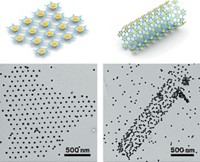Advertisement
Grab your lab coat. Let's get started
Welcome!
Welcome!
Create an account below to get 6 C&EN articles per month, receive newsletters and more - all free.
It seems this is your first time logging in online. Please enter the following information to continue.
As an ACS member you automatically get access to this site. All we need is few more details to create your reading experience.
Not you? Sign in with a different account.
Not you? Sign in with a different account.
ERROR 1
ERROR 1
ERROR 2
ERROR 2
ERROR 2
ERROR 2
ERROR 2
Password and Confirm password must match.
If you have an ACS member number, please enter it here so we can link this account to your membership. (optional)
ERROR 2
ACS values your privacy. By submitting your information, you are gaining access to C&EN and subscribing to our weekly newsletter. We use the information you provide to make your reading experience better, and we will never sell your data to third party members.
Materials
Nanonotches
Molecules and nanomaterials could be studied within nanogaps
by Bethany Halford
July 4, 2005
| A version of this story appeared in
Volume 83, Issue 27

MOLECULAR ELECTRONICS
A versatile new lithographic procedure that carves tiny gaps into nanowires may help advance the field of nanoelectronics. These precisely notched nanowires offer researchers a relatively inexpensive tool for studying the electronic properties of nanomaterials, according to the Northwestern University research team that did the notching.
In their efforts to cram as many circuit elements as possible onto a chip, researchers have been trying to create electronic devices out of the smallest components available--single molecules and nanomaterials. But making electrical contacts with these materials, to study their properties, is no trivial matter. Researchers commonly insert molecules or materials into a nanometer-scale gap between two electrodes, but creating electrodes with such tiny gaps has been cumbersome and imprecise.
Chad A. Mirkin and coworkers report a fast and controllable way to make gold electrodes having gaps that are as narrow as 5 nm (Science 2005, 309, 113). First, the team members use template synthesis to create wires in which gold segments are interrupted by short segments of either nickel or silver. They disperse and fix these wires onto a surface, coat the wires' exposed surfaces with silica, and then remove them from the surface. Finally, the team dissolves the nongold portions of the wire. The smaller the nongold segments, the smaller the gap. The silica backing keeps the gold pieces from drifting apart.
In an accompanying commentary, nanoscientist Charles R. Martin of the University of Florida points out that Mirkin and coworkers still face challenges. Although they show that polymeric materials can be used to bridge these tiny gaps, Martin says they still need to demonstrate that the structures will work with single molecules.
Nevertheless, Martin adds, on-wire lithography is likely to become an important tool in the molecular electronics toolbox.






Join the conversation
Contact the reporter
Submit a Letter to the Editor for publication
Engage with us on Twitter